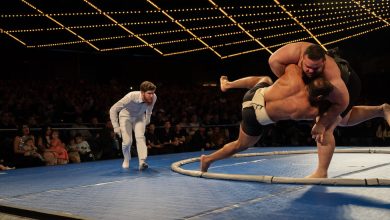Forget Heartbreak Hill. It’s Boston’s Downhills That Cause the Real Pain.

The Boston Marathon is a little more than a week away, and that means lots of runners are fretting over those final climbs, especially the notorious Heartbreak Hill at mile 20.
The dirty secret about Boston, though, is that the course also requires a skill that many of its 30,000 participants have likely spent little time thinking about or preparing for — running downhill.
The uphill sections generally get all the attention but the marathon course, which travels northeast from Hopkinton, Mass., to Copley Square in Boston’s Back Bay neighborhood, is what is known as a “net downhill” race. It loses nearly 450 feet of elevation over its 26.2 miles, making it ineligible for world records.
Much of that elevation loss occurs in the first five miles. The starting line lies 490 feet above sea level, and the first mile drops about 130 feet. The course descends another 180 feet or so by the time runners get to Framingham, Mass., the third of eight municipalities on the course, after the five-mile mark. There are some minor rises over the next 10 miles, but it’s pretty much flat and downhill as the elevation drops to just 60 feet above sea level before the Newton hills begin at the 16-mile mark.
But don’t be fooled: the downhill slope is not a joyride.
“The quadriceps muscles have to work harder going downhill to help maintain balance and to control the gravitational forces,” Bill Pierce, an emeritus professor of health sciences at Furman University in Greenville, S.C., and co-author of the popular training guide, “Run Less. Run Faster,” explained.
Countless Boston veterans are familiar with the panic that approaches when their quads begin to cramp up before the race is halfway over.
Amanda Watters, a 17-time Boston finisher and the coach for the Boston Athletic Association charity team, said the downhill portions force runners to lean back, even slightly, to prevent them from tumbling over. That adjustment causes the foot to land more closely to the heel, which creates both a different and, in some cases, greater stress on the quads, calves and hamstrings than running on flat ground or uphill would produce.
“It’s a different kind of race because you work the quads so much in the first half and then the hamstrings in the second half so you have to really prepare those muscles to stand up to the job,” said Jordan Metzl, a sports medicine physician and the author of “Running Strong: The Sports Doctor’s Complete Guide to Staying Healthy and Injury-Free for Life.”
If you are running the Boston Marathon for the first time on April 18 and didn’t get the memo on downhill training, you may be a little ticked off that we waited until 10 days before the race to write about this. (We do have some advice for your next hilly race, though. Subscribe to our weekly running newsletter here.) It is indeed too late to do anything training-wise that will really help on race day other than dialing back on the miles and avoiding injury. But there is still a way to manage the race and its descending first half that can minimize the pain and the drama that the pain can often bring.
Jess Movold, a coach on the Runner’s World+ staff, said if strength and hill training was not a part of your preparation, then focus on what you can control. Run smart. Be light and quick on your feet. Lead with your hips. Control your arms with efficient circular motions. “Be smart in that first mile as you assess what you feel like,” Movold said. “Minimize the pounding. Keep the cadence.”
In the name of Paul Revere, do not, we repeat, do not go out fast. There will likely be a runner on the bus to the starting line or in the corral bragging about going under three hours. Ignore them.
Dave McGillivray, the race director, said patience is the key, “holding back a bit in the first half so you both avoid the pounding and you have something left in the tank for the second half.” He would know. This is McGillivray’s 50th consecutive Boston Marathon. He will be running at night, after his race director duties are finished.
But holding back can be difficult on a course where it is tempting to go out fast, with the forces of gravity in the downhill sections plus all the excitement of race day. Boston has the fastest field of any big-time race. It requires nearly all runners to meet a qualifying standard. The McGillivray race plan is worth a healthy consideration, though.
“I shorten my stride a bit going down hills, almost like I’m shuffling more than running simply to eliminate all that pounding, and it works,” McGillivray said. “I might be going a little slower than I would if it was a flat stretch. That is OK, and better for me than crashing on the uphills and then doing the survivor’s shuffle for the last 10K.”



